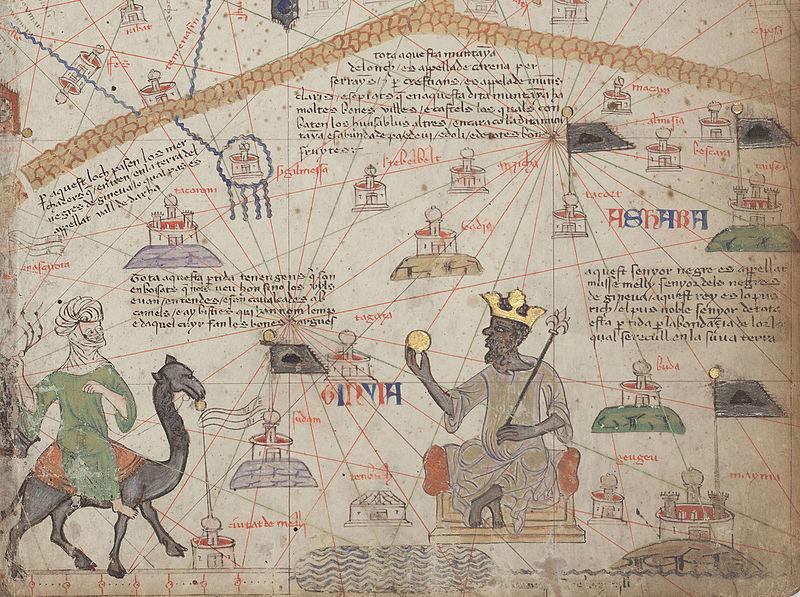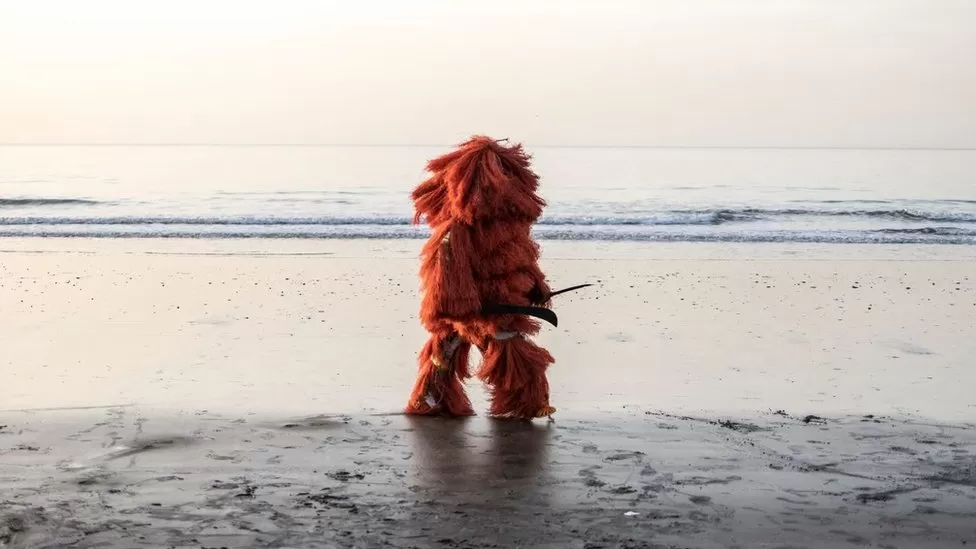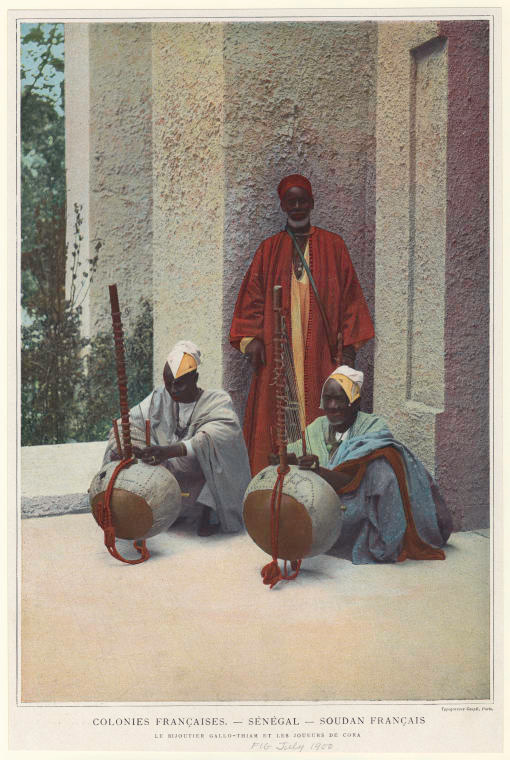The Mandé people are a unique ethnolinguistic group originating from West Africa. The term “Mande” covers a linguistically and historically related group of peoples sharing an extremely rich and vibrant historical background, the high point of which was the Mali Empire that flourished from the mid-13th to the early 15th century. Various Mande languages form a branch of the Niger-Congo language family, (Mandinka, Mandingo, Mende, Malinke, Maninke, Susu, Bambara, and Dyula). The heartland of Mande territory is in what is now northeastern Guinea and southern Mali, but Mande people are found across a much larger portion of sub-Saharan West Africa, speaking various dialects of the Manding family of languages. Recognized linguistic groups include the Maninka of northeastern Guinea and southern Mali, the Bamana of Mali, the Mandinka of Senegambia and Guinea-Bissau, the Mandingo of northern Liberia, the Kuranko of Sierra Leone, and the Dyula of northern Côte d’Ivoire. The Soninke provides a linguistic and historical substrate for much of this region. Many other culturally related groups are located around the periphery of this central zone between southern Mauritania, western Burkina Faso, northern Benin, and the Atlantic coast of Senegambia.
As descendants of one of the greatest empire, the Mali Empire founded by Sundiata Keita (c. 1214 – c. 1255), became renowned for the wealth of its rulers, especially Mansa Musa (Musa Keita). Under Mansa Musa’s reign the empire grew in unfathomable wealth which came from primarily gold and salt. Gold and salt were in abundant supply so much so that at the time approximately half of all gold in the old world which includes Africa, Asia and Europe came from three of the main gold mines in the Mali Empire. The crown jewel of Africa, the Empire of Mali was also the center of Islamic, legal, and scientific scholarship in the fable city of Timbuktu. Home of the prestigious Koranic Sankore University and other madrasas (Islamic Schools), Timbuktu was an intellectual and spiritual capital and a center for the propagation of Islam throughout Africa in the 15th and 16th centuries. Its three great mosques, Djingareyber, Sankore and Sidi Yahia, recall Timbuktu’s golden age. Although continuously restored, these monuments are today under threat from desertification. Sankore, Jingaray Ber, and Sidi Yahya are also the oldest formal universities in Africa. In a few generations, Mali was eclipsed by the Songhai empire of Askia Muhammad I (Askia the Great).
The history of theMandé people is characterized by a combination of historical events, which connected tribes with nodal locations, and cultural practices that created a societal hierarchy based on traditional knowledge. Mande mythology had a significant impact on the mythology of surrounding peoples such as the Dogon, Fulani, Serer, and Wolof. Epics such as Sundiata and the Dausi are the most known Mande legends. Mande traditional beliefs have survived to varying degrees of success into the modern-day.
TheMandé people are very magical in nature. Inhabiting everything in the universe is a force called “Nyama”. Nyama is a wild and unpredictable force that could be harnessed by skilled sorcerers for good or ill. The social caste known as “Nyamakalaw” or handlers of Nyama (blacksmiths, leatherworkers, and griots) were tasked with preventing Nyama from running out of control and shaping it for the benefit of man. Hunters lacked this natural gift, relying on magical skills and rituals instead. Another force was called “Wanzo,” a negative force which bleeds into the world from Muso Koroni’s influence. Wanzo is characterized best by impurity, ignorance, femininity, decay, and chaos. “Ni” is the vital force or soul which animates all living things. “Dya” is the spirit double, considered to be under the special protection of Faro. “Tere” which corresponds with the personality and individual character resides in the head. The tere comes from Pemba and transforms into Nyama at death.
The Mandé culture has a very strong oral tradition and history. One of the oral traditions tells the Epic of Sundiata. The epic of Sundiata theme the power of ancestral knowledge and is inherent to the telling of the epic. For not only is the story of Sundiata important, but so is the actual telling of the story important. It must not only be studied but also told, since griots maintain the history of Mali within themselves. The story is meant to be performed alongside music played by the griot mainly with the Kora. Kora is the traditional musical instrument of the Mande and it’sa stringed instrument with 21 or more strings. The instrument’s body is composed of a long hardwood neck that passes through a calabash gourd resonator, itself covered by a leather soundboard. Twenty-one leather or nylon strings are attached to the top of the neck with leather tuning rings. It is performed by families of musicians known as Jali or in French as griots. The Jalis are traditional historians, genealogists and storytellers who pass their skills on to their descendants. Though played in Guinea, Guinea-Bissau, Mali and Senegal, the instrument was first discovered in the Gambia. It is arguably the most complex chordophone of Africa and the people who play the kora have a unique gift with their dexterity with the kora.
The kora is an ancient, male-dominated hereditary tradition that has been exclusively handed down from father to son for the past seven centuries. However, a few women have broken that tradition. Notably Sona Jobarteh who is the first female Kora virtuoso to come from a prestigious west African Griot family from The Gambia. She is the granddaughter of the Master Griot of his generation, Amadu Bansang Jobarteh.
The Mande identity formed a complex and pluralized amalgamation of social and cultural factors. One of the focal points in the epic story of Sundiata is the Mande people’s family structure, which has two elements— badenya, or mother-childness. and (fadenya) “father-child-ness.” Fadenya, or “father-child-ness,” is a word used by Mandé peoples, originally to describe the tensions between half-brothers with the same father and different mothers and is represented in the epic of Sundiata by the animosity between Sundiata, son of Sogolon, and Dankaran Touman, son of Sassouma (king Nare Marghan’s first wife). The concept of fadenya has been stretched and is often used to describe the political and social dynamism of the Mandé world.
Feeling Inspired?: Visit our African Homecoming page — a page dedicated to African history, Africa’s great civilizations, people, places, history, culture, and traditions and uncover the untold stories of the diverse and vast African continent. Encompassing a wide range of experiences, the page is inspired by our travelers who are cultural ambassadors, erudite for ebullient discussions, gluttons for authentic cultural experiences and stories, with an inveterate passion for travel. We’re always here to take the guesswork out of your travel experiences to the African continent – experiences that shift perspectives and fuel imagination.






